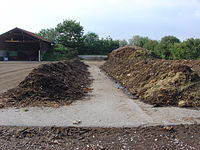
Photo from wikipedia
The speciation, bioavailability and environmental risk of heavy metals (HMs) in the hydrochar derived from hydrothermal carbonization (HTC) of swine manure were investigated in this study. The results indicated that… Click to show full abstract
The speciation, bioavailability and environmental risk of heavy metals (HMs) in the hydrochar derived from hydrothermal carbonization (HTC) of swine manure were investigated in this study. The results indicated that the majority of HMs originally in swine manure were retained in the hydrochar by HTC, and CaO addition substantially reduced the HMs concentration in the hydrochar. HTC especially CaO assisted HTC significantly promoted the HMs transformation from the bioavailable fraction to the relatively stable fraction, and thus decreased their environmental risk in the hydrochar. Moreover, the Toxicity Characteristic Leaching Procedure and diethylenetriamine pentaacetic acid test revealed that the leachability and plant-bioavailability of HMs in swine manure were greatly declined by HTC especially for HTC with 15% CaO addition. The present study suggested that HTC was an effective disposal approach for swine manure from the perspective of HMs immobilization, especially for CaO assisted HTC.
Journal Title: Journal of environmental management
Year Published: 2019
Link to full text (if available)
Share on Social Media: Sign Up to like & get
recommendations!